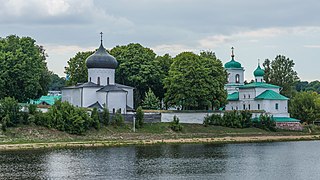
A World Heritage Site is a landmark or area with legal protection by an international convention administered by UNESCO. World Heritage Sites are designated by UNESCO for having cultural, historical, scientific or other forms of significance. The sites are judged to contain "cultural and natural heritage around the world considered to be of outstanding value to humanity".

Asmara, or Asmera, is the capital and most populous city of Eritrea, in the country's Central Region. It sits at an elevation of 2,325 metres (7,628 ft), making it the sixth highest capital in the world by altitude and the second highest capital in Africa. The city is located at the tip of an escarpment that is both the northwestern edge of the Eritrean Highlands and the Great Rift Valley in neighbouring Ethiopia. In 2017, the city was declared as a UNESCO World Heritage Site for its well-preserved modernist architecture. According to local traditions, the city was founded after four separate villages unified to live together peacefully after long periods of conflict. Asmara had long been overshadowed by nearby Debarwa, the residence of the Bahr Negash or the governor of the coastal province, however it still existed as a major settlement for over half a millennium and enjoyed some importance as it stood on the trade route to Massawa. Asmara first rose to prominence during the 20th century, when it became capital of Italian Eritrea. Under Italian rule the city of Asmara experienced rapid urbanization and modernization.

Pskov is a city in northwestern Russia and the administrative center of Pskov Oblast, located about 20 kilometers (12 mi) east of the Estonian border, on the Velikaya River. Population: 193,082 (2021 Census); 203,279 (2010 Russian census); 202,780 (2002 Census); 203,789 (1989 Soviet census).
Ivrea is a town and comune of the Metropolitan City of Turin in the Piedmont region of northwestern Italy. Situated on the road leading to the Aosta Valley, it straddles the Dora Baltea and is regarded as the centre of the Canavese area. Ivrea lies in a basin that in prehistoric times formed a large lake. Today five smaller lakes—Sirio, San Michele, Pistono, Nero and Campagna—are found in the area around the town.

Mtskheta is a city in the region of Mtskheta-Mtianeti, Georgia. It is one of the oldest cities in Georgia as well as one of the oldest continuously inhabited cities in the world. It is located approximately 20 km (12 mi) north of Tbilisi, at the confluence of the Mtkvari and Aragvi rivers. Currently a small provincial capital, for nearly a millennium until the 5th century AD, Mtskheta was a large fortified city, a significant economical and political centre of the Kingdom of Iberia.

Kyiv-Pechersk Lavra or Kyievo-Pecherska Lavra, also known as the Kyiv Monastery of the Caves, is a historic Eastern Orthodox Christian monastery which gave its name to one of the city districts where it is located in Kyiv.

The Monastery of Saint Thaddeus is an ancient Armenian monastery in the mountainous area of West Azerbaijan Province, Iran. It is believed to be one of the oldest church buildings in the world.

The Baroque Churches of the Philippines are a collection of four Spanish Colonial-era baroque churches in the Philippines, which were included in UNESCO's World Heritage List in 1993. The churches are also considered as national cultural treasures of the country.

Ani is a ruined medieval Armenian city now situated in Turkey's province of Kars, next to the closed border with Armenia.

The architecture of the Philippines reflects the historical and cultural traditions in the country. Most prominent historic structures in the archipelago are influenced by Austronesian, American architectures.

The Armenian Monastic Ensembles of Iran is a UNESCO World Heritage Site located in the West Azerbaijan and East Azerbaijan provinces in Iran. The site comprises three groups of Armenian churches that were established between the 7th and 16th centuries A.D.

Mirozhsky Monastery is a 12th-century Russian Orthodox monastery complex in Pskov, Russia, famous for its frescoes, located in the Christ's Transfiguration Cathedral. The name of the monastery is derived from the name of the Mirozha River, since the monastery is located at the place where the Mirozha joins the Velikaya River, on the left bank of the Velikaya. The catholicon of the monastery is one of the two pre-Mongol buildings which survived in Pskov, and contains the frescoes of the 12th century. The monastery, together with the Transfiguration Cathedral, is part of the Churches of the Pskov School of Architecture, which became an World Heritage Site in 2019.

The Historic Monuments of Novgorod and Surroundings is a composite World Heritage Site which includes a number of medieval monuments in and around Veliky Novgorod, Russia. The site was inscribed in 1992.

The Convent of Nativity of Saint John the Baptist is a former Russian Orthodox nunnery in Pskov. It is notable for the katholikon, one of Russia's oldest churches, dating from the first half of the 12th century. The church is located at the city center, on the left bank of the Velikaya River, in the Zavelichye quarter. It currently belongs to Krypetsky Monastery. It is the second oldest building in Pskov after the katholikon of the Mirozhsky Monastery and was designated an architectural monument of federal significance (#6010016003). The Cathedral of Ioann Predtecha is part of the Churches of the Pskov School of Architecture, which became an World Heritage Site in 2019.
The 20th-Century Architecture of Frank Lloyd Wright is a UNESCO World Heritage Site consisting of a selection of eight buildings across the United States that were designed by American architect Frank Lloyd Wright. These sites demonstrate his philosophy of organic architecture, designing structures that were in harmony with humanity and its environment. Wright's work had an international influence on the development of architecture in the 20th century.













